Table of Contents
Folk Regions
Three Ethnic Perspectives
Folk Music of the Florida Parishes
People of the Florida Parishes
In Retrospect

Hungarian Folklife in the Florida Parishes of Louisiana
By Virginia Romero
Introduction
Mike Odor relishes the chicken paprikas that his wife, Olga, prepares. He admires the colorful costumes which she sews for the Hungarian dancers. He attends the Hungarian Presbyterian Church and belongs to the Arpadhon Hungarian Settlement Cultural Association. When the Hungarian State Folk Ensemble comes to Baton Rouge, he travels there to see it. Mike's years in military service took him abroad—east to Germany and west to Hawaii—but, since his retirement, he has lived in the area of his birth, where he and Olga helped tend the needs of her mother, who is now deceased. Mike does not farm the land there, but he caresses the land in pen-and-ink drawings of the landscapes and buildings that represent Hungarian Settlement.
Many of Mike Odor's activities are part of the way of life of the people of Hungarian heritage living in southeast Louisiana. Yet, Mike is convinced that the folklife of these people is not strictly Hungarian. He spends a lot of time pondering the essence of existence, striving to become mentally one with the landscapes he sketches, and remembering that each structure he draws was once somebody's dream. Mike's activities and observations give insight into the character of Hungarian folklife in the Florida Parishes.
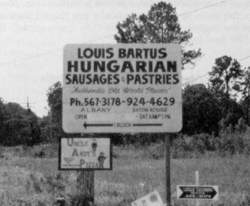
The life these people live today would represent fulfillment, indeed, for the dreams of their land-hungry forebears. Since the 1890s, settlers of Hungarian heritage, seeking land and respite from grinding poverty, have moved into an area close to what is now the Albany-Springfield exit of I-12. The Louisiana Tourist Development Commission erected a marker in 1976 for the point these new settlers had called "Arpadhon," and which settlers before them had christened "Hungarian Settlement." Later, some Hungarian Americans moved north toward Albany or south toward Springfield, but most did not move far. When they did leave, often they returned at some point in their lives to resume family obligations and to claim hard-won family property. Aspects of folklife in their language, dance, song, and foodways have long been recognized in domestic, educational, and religious settings in the area.
But Hungarian Settlement is no "Brigadoon." What is known as Hungarian folklife reflects the influence of French, Italian, English, Scotch, German, Irish, and every other element that shaped this segment of America, all filtered through the memory of Hungary-as-homeland. Hungarian Settlement has dealt with and has incorporated change. That its folklife thrives today is joint testimony to that change and to the desire, more ardent in some than in others, to hold dear the memory of Hungary-as-homeland, and to pass it onto future generations.
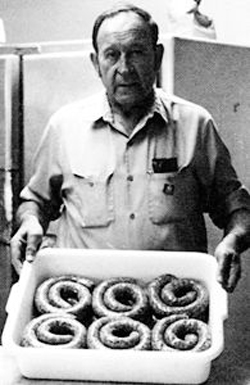
The Louisiana Hungarian folklife that results from such assimilation blends what-was in Hungary along with what-is in Hungarian Settlement. It is not necessary to separate these currents; yet, it is important to know that they are there, for this knowledge clarifies certain confusions that otherwise exist. What follows are some examples.
First, the language which adults in Hungarian Settlement learned from their elders often does not communicate readily to the ear of the man who speaks fluent native Hungarian, and the reverse is also true. The early settlers spoke Hungarian as it was spoken at the time. Through the years, native Hungarian changed, just as Elizabethan English has changed into modern English. In Hungarian Settlement, however, the idioms, word meanings, and tempo of speech did not change in the same way. The vintage language, passed down through generations and other linguistic influences, sometimes bears little resemblance to the language spoken in Hungary today.
Second, some music, thought to represent ancient native melodies, is, in fact, of more recent composition. Early settlers did bring their songs with them. The women sang as they took lunch pails to the men at work, and as they packed strawberries in the shed. Grandmothers taught these songs to the children when their mothers did not have the time. Showtunes composed in Hungary in the 1920s filtered through the centers of Hungarian population in the eastern United States, and they were added, with mutations, to the musical heritage. These elements all contribute to the music of Hungarian Settlement.
Third, dance costumes in the local settlement, with motifs never used in the homeland, are red, green, and white whereas in Hungary the costumes use other colors, too. Many of the early settlers never owned a costume in the homeland. They made costumes based upon memory and chose the colors of the Hungarian flag to honor the homeland.
These currents are most often ignored, but they can be recognized without detracting from the phenomenon of substantial Hungarian folklife in the Florida Parishes.
Costume, Dance, And Song
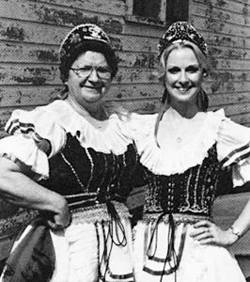
Olga King Odor now makes the dance costumes for those members of the community who do not want to make their own. She makes them in red, green, and white, as did her mother, Elizabeth Hudak King, who was a costume maker before her. The costumes Olga makes for the ladies feature a bodice and vest attached to flowing skirt, a lace-trimmed apron, and sequins, braid, and ribbon trimming applied in such a way as to catch the light when the dancer swirls. The motifs have no particular significance, Olga explains. She uses whatever design that she and the wearer decide upon. The man's costume has flowing pantaloons, flowing sleeves, and black vest. There are headdresses for the ladies, and black hats for the men. Olga has fitted a two-year-old child and a four-hundred-pound adult. She provides the materials and sews the costumes for a nominal fee, as her contribution to preserving the heritage of Hungarian Settlement.
Occasionally circumstances favor closer emulation of native Hungarian custom. For instance, the ladies in the local dance group once considered changing their low-heeled shoes for boots. It was a crucial decision. Hungarian dancers in Hungary wear boots, and Hungarian dancers in Hungarian Settlement have always worn low-heeled shoes. Anna Kovach Arceneaux, then coordinator of the dancers, opted for continued use of the shoes. Different areas in Hungary use different costumes, she pointed out, and Hungarian Americans of the Florida Parishes should keep what is indigenous to their own culture. More recently, however, the ladies chose to wear boots.
Anna has been dancing since she was twelve years old, at which time dancing and rehearsing were among the few acceptable recreational outlets for young folks. Ten to twelve couples, all children, learned the steps from their elders and performed often. Anna heard all her life that traditional dancing would soon be dead, but she and other interested people refused to let that happen. An adult group is active today, and dancers—young and old—form a vital part of the community. The dance group's goal is a polished performance, but the leaders reject rigid standards of perfection, preferring to keep the dance appealing to all. Teachers such as Helen Nyeki Miller, her daughter Sue Nyeki Martin, and Betty Gill continue to keep the dancing tradition alive.
For years, the band's leading musicians were men who played by ear. They played the songs as they learned them in their youth. From tapes made of these renditions, Anna and Maxine Miller Witcher annotated the music as best they could and, in consultation with others, wrote down the lyrics. They collected these songs, along with accounts of traditions and historical occurrences, over a period of several years and co-authored, in 1979, Living Heritage: Hungarian Folk Songs and Dances, published by the Arpadhon Hungarian Settlement Cultural Association. Recently, a member of the community, Joe Dick, has produced the old melodies electronically.
Organized Activity and the Hungarian Language
The Arpadhon Hungarian Settlement Cultural Association includes less than forty active members in a community that probably numbers two thousand Hungarian-connected individuals. Membership in this organization is open to all, Hungarian or not. Dues are three dollars per year.
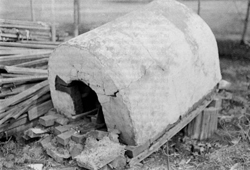
To members, "being Hungarian" is a matter of prime importance. They are certainly Americans first; indeed, several are retired military men. Yet, they are all aware that sharing the Hungarian heritage is a lot like eating strawberries—not necessary, but certainly a special treat. These are the people who wear the Hungarian costumes, who dance the Harvest Dance, who sing the Hungarian songs, learn to speak the language, and who cook and eat the Hungarian foods. Of course, they are not the only ones in the community who do so, but they choose to give voice to their Hungarian spirit through their organization.
There is a long tradition of organized Hungarian activity in this country. The first Hungarian society was formed in 1849 in New York, where the first officially noted Hungarian Folk Festival was held in 1884. When the Arpadhon Hungarian Settlement Cultural Association was organized in 1976, 187 Hungarian societies functioned in eighteen states.
The genesis of the organization dates to the Bicentennial, when Hungarian Americans of the Albany-Springfield area were invited, as the largest rural settlement of Hungarian heritage in the United States, to participate in the Festival of American Folklife in Washington, D.C., sponsored by the Smithsonian Institution. As they prepared for and participated in this memorable occasion in August 1976, they gained a heightened perception of the value of their heritage and the importance of preserving it. This perception gave impetus to the formal structuring of the Arpadhon Hungarian Settlement Cultural Association and support to the projects which it sponsors.
When Mary Hosh Resetar served as "mouthpiece" for the Hungarian Americans of the Albany-Springfield area on their Washington visit in 1976, she was already well aware that her fluency in the language was an asset. Mary, who grew up in the Hungarian Settlement, had lived in Michigan for thirty-five years, had worked with the Hungarian Americans there, and had served as an interpreter for Hungarian refugees in the 1950s.
"Mama, make her stop talking Hungarian to me in the schoolyard," Mary's brother once cried, "The others laugh." Mary's mother had reacted instantly. "Never be ashamed of your mother's tongue!" she had scolded, and the punishment she had meted out accentuated the seriousness of the crime.
Thus, in Mary's youth, and in the youth of many others, Hungarian was not only taught in the home, it was protected, and respect for it was demanded. The early settlers believed that you were not truly Hungarian if you did not speak the language. Many of them intended firmly to return to Hungary. To maintain citizenship, some sent their wives back to the homeland when childbirth was imminent. The children would surely need to know the language when time came for permanent return. Hungarian was taught from the cradle, and English would have to wait until the children went to school.
As times changed, though, the older people grieved to find their adult children letting Hungarian fall into disuse. Grandparents continued to teach as much as they could. Formal efforts were made to teach Hungarian in religion classes, particularly through the efforts of the Presbyterian minister, Reverend Alexander Bartus.
Nevertheless, in 1951, an informant told John H. Allen, ". . . those kids don't care anything about the old language." Allen concluded, after investigation, that " . . . young people and children show little or no interest in the Hungarian language and only tolerate its use by their elders." In early 1976, it was believed that the Hungarian language was facing extinction in southeast Louisiana.
Then came the Bicentennial and a bilingual program which met with great success. By 1984, five different teachers from Hungary had lived in the community, bringing new perspective to many adults and enabling hundreds of youngsters to hear different sounds, think different thoughts, and perceive different dimensions. One-hundred fifty students at Albany Elementary School were learning the Hungarian language and way of life in daily half-hour classes.
The Hungarian teachers and the Hungarian-American coordinator, Alex Kropog, taught the students games, dances, songs, rhymes, and folktales. Many of the students were of Hungarian heritage, while others were not. Some were Black, and some were Asian American. They counted together in Hungarian, located sites on a map of Hungary, and listened to a non-Hungarian sixth-grader recall a visit to Hungary.
Adults were attending evening classes to learn the language and culture. They were singing together, and had added Hungarian songs to worship services at both St. Margaret Catholic Church and the Hungarian Presbyterian Church. Many of them had participated in "Summer in Hungary" programs through the efforts of Southeastern Louisiana University, the Livingston Parish School Board, and the World Hungarian Federation. The Arpadhon Hungarian Settlement Cultural Association became stronger, and the community also gained through this organized activity. [Editor’s Note: The Hungarian language program was cut in 1986. Little Hungarian is spoken in 2000.]
Stuffed Cabbage and Coffee Cake
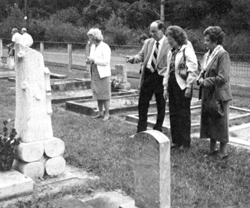
Retention by organized activity is less apparent in the foodways than in other aspects of folklife. For example, there is no Hungarian restaurant in the Albany-Springfield area; however, you can buy Hungarian sausage and pastry there, or arrange for a meal to be served "Hungarian style." You will also find Hungarian foods in abundance at festivals, at weddings, and in private homes.
Alex Berey makes cabbage rolls, "when I'm hungry for them or when ‘Boots’ (his wife) wants to show me off." Boots is not Hungarian, but she enjoys serving guests the hearty Hungarian fare that Alex prepares as a specialty. He demonstrates the step-by-step procedure that he learned by watching his mother.
Alex explains that in his youth he had to live on what the family grew. There were special foods for festivals and weddings: baked chicken, roast pork, stuffed goose, and always soup. His mother made soup of Irish potatoes and sour cream and of green beans and sour cream. She baked their bread and, on unforgettable occasions, would add a suckling pig stuffed with bread crumbs, onions, and hard-boiled eggs to cook in the outdoor oven along with sweet potatoes and the week's supply of bread.
Cabbage rolls, or stuffed cabbage, was a Sunday dish. Alex's brother, five years younger, made family lore the day their mother doubled the quantity of cabbage rolls. "Oh, goody, goody!"The boy cried, "We have two pots of cabbage!"
Alex Berey's Cabbage Rolls
2 medium onions
1 can tomato soup
Crisco oil
1 can mushroom soup
2 cabbage heads
salt, black pepper, paprika
1 pint sour cream
2 pounds ground meat
2 T. flour
2 cups long grain rice
3 ham hocks
- Saute onion in oil.
- In large bowl, combine meat, sauteed onion, rice, seasonings.
- Core two cabbage heads. Bring water to boil in large pot. Place cabbage heads in hot (not boiling) water. Let cabbage sit until leaves are soft and separate easily.
- Remove heads from water; separate leaves. Chop small leaves; trim veins on backs of large leaves.
- Make sauce, blending soups and sour cream until smooth.
- Place leaf in palm of hand. Put 1 T. prepared meat-rice-onion mixture in center. Fold leaf over in half; fold bottom up. At the top, poke leaf in over the mixture so that it will stay together.
- Place ham hocks in bottom of pot on bed of chopped leaves. Stack cabbage rolls around ham hocks. Pour sour cream-soup sauce over rolls. Cover; cook until rice is done.
Julia Gaydos Prokop bakes every other day. She makes noodles on a large board with a lip that fits over the edge of the table, or counter, to allow a more stable base for rolling. The rolling pin is narrow, about the width of a broomstick. Julia now uses Gold Medal flour (twenty pounds a week, in fact), but she remembers when her father had to drive to Mississippi every summer to buy flour by the wagonload because the local product was full of worms.
Julia shares many tips for better baking. These are a few. Hold your hands at the ends of the rolling pin if you want the dough to roll out easily. Beat eggs before adding them to dough; unbeaten egg whites pull the dough back to the center. Use bakers' yeast, not packaged yeast. Buy it in bulk from the bakery. Store what you do not need, wrapped in a paper towel, in an airtight container. If yeast loses its strength, flush it down the toilet; it is good for the septic tank.
Julia approves, basically, the recipe for Hungarian Coffee Cake as it appears in Hungarian Recipes. Although, she likes to make several changes when she bakes this.
Hungarian Coffee Cake
1 cup sour cream
4 1/2 cups flour
1/2 cup sugar
1/2 cup melted butter
1 tsp. salt
1 cup chopped walnuts
2 cakes yeast
3/4 tsp. cinnamon
3 eggs
1 cup sugar
1/2 cup soft butter
- Mix sour cream, sugar, salt, and yeast. Stir until yeast dissolves. Add eggs, softened butter and half the flour. Mix well and add rest of flour.
- Turn dough out on floured board and knead until smooth for about 10 to 15 minutes. Place in a greased bowl. Cover and let rise in warm place until double in bulk for about 1 1/2 to 2 hours. Punch down. Turn over and let rise again for 45 minutes. After second rising, form into walnut-sized balls. Dip in melted butter. Roll in sugar and walnut-cinnamon mixture. Place in layers in a 10-inch greased tube pan.
- Let rise 45 minutes. Bake 40 to 50 minutes at 375 degrees.
- Julia's Suggestions: Use bakers' yeast. As soon as dough rises, put a small amount in your hand and roll it; it does not have to be round. The softer the dough the better. Bake at 300 degrees for forty-five minutes. Raise to 350 for last fifteen minutes to make the coffee cake rosy red. To help the dough balls stick together, put less sugar in the dough and add it to the coating mixture.
Cultural Conservation Efforts
Hungarian folklore honors Arpad, the legendary hero who united Magyar tribes in 800 A.D. Hungarian Settlement was originally called Arpadhon, "Home of Arpad." Today in Hungarian Settlement, the memory of Arpad shares honor with the memory of another folk-hero, a counterpart to Arpad who fought in modern times, and also for unity. The unity that this man sought was a oneness of the present with the past, a union of folklife and the determination to preserve it. The folk-hero who fought this battle with such devotion was Reverend Alexander Bartus.
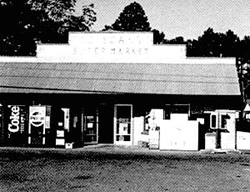
"Preacher" Bartus, as he was called, was a Presbyterian minister, a builder, a leader, both spiritual and temporal, and, surely, a prophet. His name arises instantly in any conversation about Hungarian folklife. He taught the language along with religion in summer schools. He used Hungarian in church services, funerals, weddings, and whenever he considered it feasible. He promoted festivals and the Harvest dance, interpreting their significance for onlookers. His struggle to preserve folklife, and to involve the community in preserving it, achieved a legendary quality.
Almost like a recalcitrant child, though, the community held back, giving only half-hearted support to his ideas for preservation. Then came the Bicentennial, the beginning of renewal, and shortly afterwards, on May 2, 1977, the death of "Preacher" Bartus. Hungarian Settlement had lost its father-figure, its chief link with the past. It became very clear that, if the Hungarian Americans wished to preserve their heritage, they would have to find a way to do it themselves. This is the mission they have now undertaken.
Mike Odor's drawing of a Methodist chapel near his home shows the present structure along with those which preceded it. Mike believes that it is necessary to depict all these phases in the development of that institution, in order to give a complete picture of the structure as it exists today. The present leans upon the past, he finds, just as does folklife.
Paradoxically, the longer that the Hungarian Americans lean upon their past, the stronger their folklife becomes in its own right in Louisiana's Florida Parishes.
Bibliography and Archival Resources
Allen, John H. "A Sociological Analysis of a Hungarian-American Community." M.A. Thesis, Louisiana State University, 1951.
Arceneaux, Anna Kovach, and Witcher, Maxine Miller. Living Heritage: Hungarian Folk Songs and Dances. Lafayette: Acadiana Music, 1979.
Arceneaux, Anna Kovach. Albany. Interview by Virginia Romero, April 24, 1984.
Arpadhon Hungarian Settlement Cultural Association. Albany. Interview by Virginia Romero. February 13, 1984.
Bartus, Alex C. Albany. Interview by Virginia Romero, February 13, 1984.
Bartus, Louis. Albany. Interview by Virginia Romero, May 20, 1984.
Berey, Alex. Albany. Interview by Virginia Romero, February 13, 1984.
Blackwell, Laura. Albany. Interview by Virginia Romero, January 17, 1984.
Borocz, Jozsef. Albany, Louisiana. Interview by Virginia Romero, January 17, 1984.
Carr, Betty Bankston. "Hungarians in America." Research paper, Louisiana State University, 1976.
Carr, Betty Bankston. Hammond. Interview by Virginia Romero, March 13, 1984.
Carter, C. "Problems of Adult Education Classes Among the Hungarians in Tangipahoa and Livingston Parishes." M.A. Thesis, Louisiana State University, 1935.
Dorcas Guild. Hungarian Recipes. Ohio: Dorcas Guild of the Magyar United Church of Christ, 1960.
Drude, S. Ponchatoula. Interview by Virginia Romero, April 13, 1984.
Groene, Bertram H. Crossroads of the Deep South, Our People and Progress. Hammond: Ninth Annual Southeast Louisiana Agri-Dustrial Futurama, 1970.
Hess, George. Albany. Interview by Virginia Romero, May 19, 1982.
Huszar, John. Albany. Interview by Virginia Romero, February 13, 1984.
Kropog, Alex. Albany. Interview by Virginia Romero, February 13, 1984.
Minton, James E., ed. The Free State, A History and Place-Names Study of Livingston Parish. Livingston: Livingston Parish American Revolution Bicentennial Commission, 1976.
Molran, Gyula. "Diary of a Teacher of the Hungarian Language in America." Translated by Kriszta Venczel.
Odor, Mike. Springfield. Interview by Virginia Romero, January 26, 1984.
Odor, Olga King. Springfield. Interview by Virginia Romero, January 26, 1984.
Prokop, Julia Gaydos. Albany. Interview by Virginia Romero, February 1, 1984.
Resetar, Mary Hosh. Springfield. Interview by Virginia Romero, February 1, 1984.
Szeplaki, Joseph. The Hungarians in America, 1583-1973: A Chronology & Fact Book. New York: Oceana Publications, Inc., 1975.
For more information:
Mocsary, Victoria Ann. 1990. Arpadhon: The Largest Rural Hungarian Settlement in the United States. Hammond, LA: Center for Southeast Louisiana Studies, Southeastern Louisiana University. Folklife in the Florida Parishes, Volume 6.
Romero, Ginger. 1987. Hungarian Folklife: "The Sweet Taste of Yesterday" in the Florida Parishes of Southeast Louisiana. Folklife in the Florida Parishes Series, vol. 3. Hammond: Southwestern Louisiana University, Center for Southeast Louisiana Studies.


